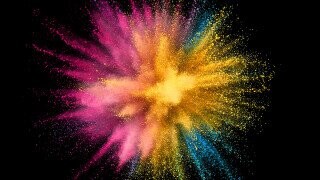Why Some Colors Are Rarer than Others

Believe it or not, colors aren’t all naturally existent. The hot pink you see on children’s unicorn t-shirts isn’t specifically a thing of the past. Some colors have been created synthetically, while others feature nature’s color palette as their inspiration. But what makes some colors rarer than others?
One color that does not exist in nature, unless you consider black holes a part of nature, was an experiment known as Vantablack or “Vertically Aligned Nano Tube Arrays.” It can absorb UV rays and has a low ability to reflect light, as well as a high thermal shock resistance. The “closest thing to a black hole that we’ll ever see,” this “color” nearly makes its subjects appear 2D. Because it absorbs so much light, its victim can never escape its depths. Allowing nearly no incident light to escape its surface, it therefore resembles a deep black hole, here on Earth.
Don't Miss
Vantablack is the darkest pigment made from humans. What makes it so rare is its availability as it requires a strenuous production process. Think you’d like to ride in a 2D-looking vehicle despite how problematic that could be for other drivers?
Another rare color made rare on purpose, known as “Stuart Semple Pink”, the “self-proclaimed pinkest pink,” was created by British artist Stuart Semple, after finding out that Vantablack would officially be licensed for exclusive use to creator Anish Kapoor. Semple was angry, so he made this pink shade available to everyone besides Kapoor, and boy was he really missing out…

For an object to have color, it must originate from a pigment. Pigments, throughout history, have varied in availability, worth, and use. Ultramarine blue, for instance, pretty close to Sesame Street’s cookie monster shade, was once worth more than gold. As early as the 14th century, the pigment was mined in Afghanistan, then shipped by boat. As Fast Company points out, “the color was so expensive that it had to be a separate line item on the bill for the painting.” It was even used to demonstrate a person's social status. So maybe the cookie monster’s better off than we thought, pampered in that nice coat of ultramarine pelage. Though before you go chasing the cookie monster for his fur, consider the fact that this blue is easier to come by now, even if synthetically. Come 1826 and it was produced artificially by a chemist, making the color a convenient find.

The rarest colors are those created out of spite and withheld, as evident by Semple, or simply because they're hard to come by.
While most mimic nature, the very concept of color is a human-made idea, as light reflected can only be interpreted by the viewer's eye. So rare or not, what you see is what you get unless, of course, you're staring into the abyss of Vantablack.